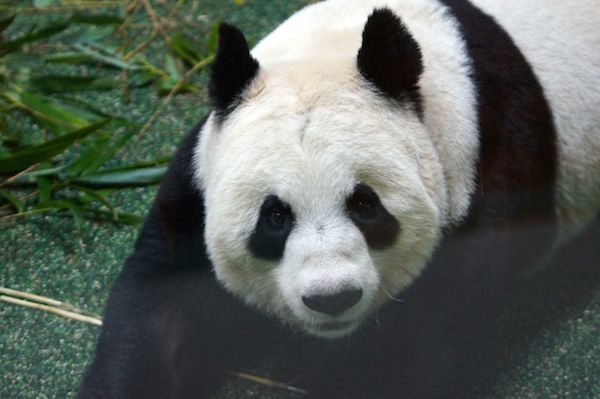Pandawatch begins – will it be third time lucky?
Yes it has started again. Following the delivery of the two giant pandas to Edinburgh Zoo there were high hopes that they would produce a cub. Sadly the first year that they were in residence this did not happen. Last year it appeared that the pandas had been successful following an artificial insemination procedure. Now Edinburgh Zoo’s giant pandas are one step closer to the anticipated 36 hour annual breeding window, with experts confirming a crucial hormone crossover in female panda Tian Tian has now taken place and that she should come into oestrus within the next seven to 14 days.
Working with endocrinologists from the Queen’s Medical Research Institute (QMRI) at the University of Edinburgh, who analyse daily urine samples taken from Tian Tian, the Royal Zoological Society of Scotland’s (RZSS) panda experts have been able to confirm the all-important crossover of hormones took place on Tuesday 1 April. The crossover occurs when oestrogen levels rise higher than progesterone levels.
The team will continue to closely watch Tian Tian’s behaviour over the coming days to gauge when her 36 hour breeding window begins, and this behavioural monitoring will be backed up by further hormone analysis which will show a sharp rise then sudden drop in oestrogen levels when Tian Tian comes into oestrus. In her first year at Edinburgh Zoo, this occurred on day eight after the hormone crossover, while in 2013 it occurred much later on day 14.
We visited the Zoo this week and spoke with Professor Chris West the CEO of RZSS about the pandas and their importance to the zoo and to conservation. We also asked him the all important question about the probability of an Edinburgh born panda cub.
[youtube https://www.youtube.com/watch?v=PJZ2LN6aidk]
Much like last year, RZSS is working with a large team of international experts on the science behind giant panda breeding. Panda behaviour expert Professor Wang Chengdong, from the China Conservation and Research Centre for Giant Pandas (CCRCGP), flew into Edinburgh yesterday to assist in decoding Tian Tian and Yang Guang’s behaviour in the run up to the breeding window.
In 2013 Tian Tian fell pregnant after artificial insemination, carrying almost to full term. This was ground-breaking science and the first time such a procedure was performed on a giant panda in the UK. Her 36 hour breeding window showed she wanted to mate, but her behaviour suggested she would not be responsive to our male panda, Yang Guang; putting them together potentially posed risk of injury. In the wild this would not be a problem as she would find and mate with multiple partners during this short time. In the Zoo however, this means they used artificial insemination, the recommended method by the Chinese.
Iain Valentine, Director of Giant Pandas for the Royal Zoological Society of Scotland, said:
“Panda breeding season is progressing nicely and over the coming days, both Tian Tian and Yang Guang’s behaviour will become much more pronounced as we get closer to the breeding window. They will become more restless, scent-marking will increase and they will call to each other. Now that we have seen the hormone crossover we will begin enclosure swapping more regularly, which encourages breeding behaviours. Panda breeding season remains a delicate and complex affair, which takes in cutting-edge science from not only within Scotland but also abroad.”
When Tian Tian is in oestrus, keepers will attempt natural mating as well as artificial insemination. Artificial insemination and reproduction specialists Professor Dr Thomas Hildebrandt, Dr Frank Göritz and Dr Joseph Saragusty, from the Leibniz Institute for Zoo and Wildlife Research (IZW) in Berlin, will once again oversee the procedure. Finally, Dr Forbes Howie at QMRI who has been leading on the hormone analysis of Tian Tian’s urine, will continue to play an important role post-breeding season in looking for signs of pregnancy.
The science behind panda breeding season forms just one of many aspects of RZSS’s giant panda conservation and research project. As well as assisting with genetic and ecological research, RZSS also provides funds for work in the wild, such as the construction of bamboo corridors which allow many species, including pandas, to cross into previously isolated reserves.
Iain Valentine continued:- “The survival of the giant panda is crucial. Firstly, the species does not live in a vacuum and a lot of panda conservation resources go towards managing and protecting a large amount of reserves in China, which also directly benefits other species living within these areas. Secondly, giant pandas act as ambassadors, raising awareness about conservation in general; when visitors come to see Tian Tian and Yang Guang they also learn about the plight of many other animals, the importance of preserving ecological diversity and how they can help.”

